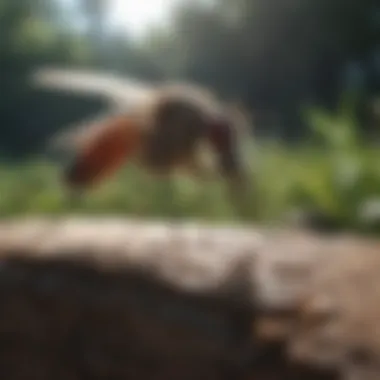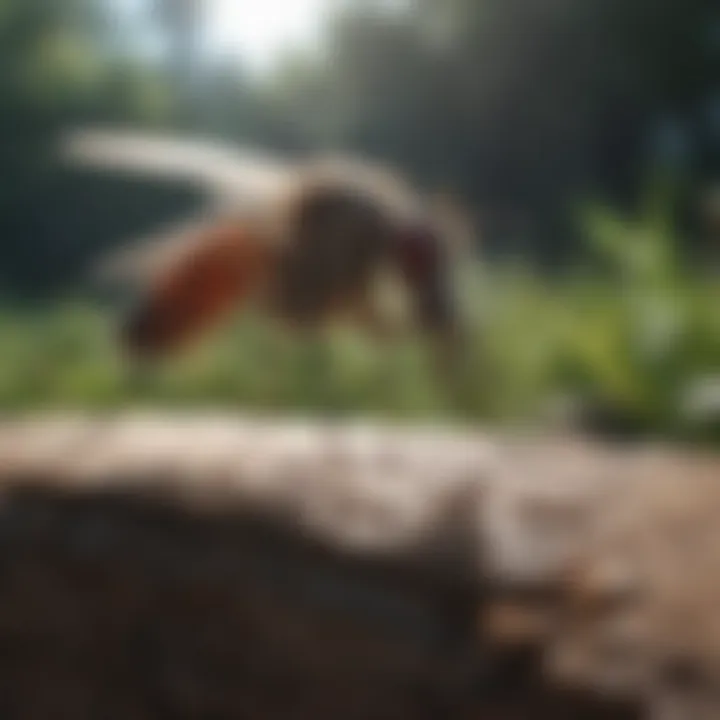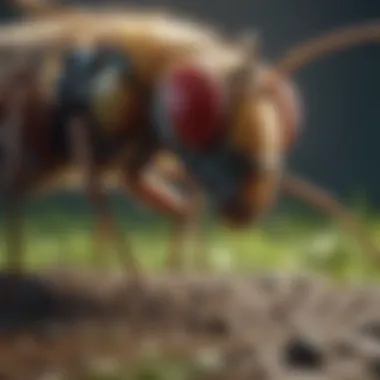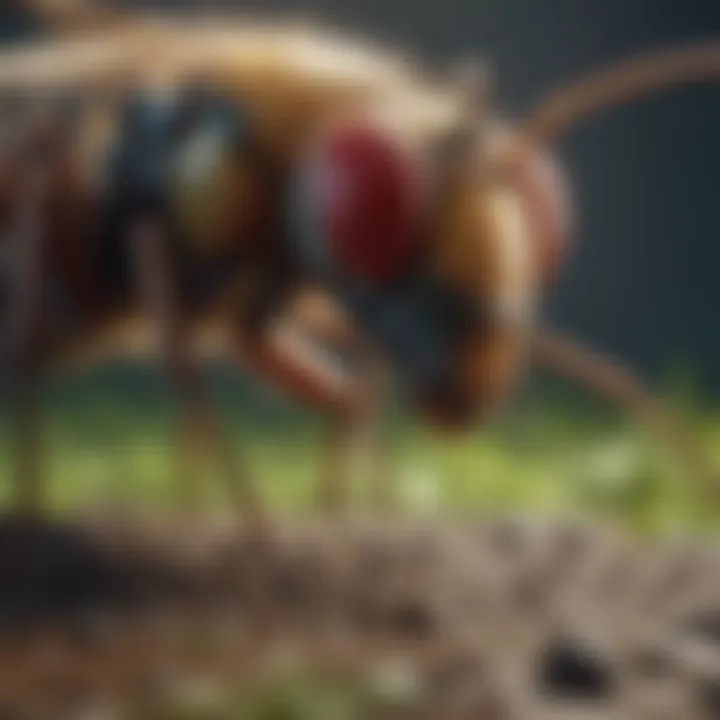Evaluating Top Chemical Solutions for Mosquito Control


Topic Overview
Definition and Importance
Mosquito control is a critical component of public health management, impacting both community well-being and agricultural productivity. Mosquitoes are known vectors for various diseases, including malaria, dengue fever, and Zika virus. Controlling their populations effectively not only prevents the spread of these diseases but also contributes to a more enjoyable outdoor experience for people. This article will explore the best chemical solutions for mosquito control, focusing on their efficacy, environmental impact, and safety measures.
Brief History and Evolution
The approach to mosquito control has evolved significantly over the decades. In the early 20th century, the use of DDT marked a turning point, creating a newfound interest in chemical insecticides. However, as the understanding of environmental consequences deepened, the industry shifted towards more targeted and sustainable solutions. Modern insecticides, such as pyrethroids and insect growth regulators, offer better efficacy while minimizing non-target species impact. Today, the emphasis lies on creating integrated pest management strategies that combine chemical methods with biological and cultural practices.
Key Techniques and Innovations
Sustainable Farming Practices
Sustainable agriculture emphasizes reducing chemical dependency while maintaining productive yields. Integrated approaches include crop rotation, using native plants that discourage mosquitoes, and enhancing biodiversity in farming settings. Employing these practices fosters a healthier ecosystem, which can lead to reduced mosquito populations naturally.
Advanced Agronomic Technologies
The advent of technology has permitted more precise application of chemical solutions for mosquito control. Innovations like drone technology enable the targeted spraying of insecticides, minimizing waste and reducing exposure for non-target organisms. Emerging solutions, such as genetically modified organisms (GMOs) that produce sterile mosquitoes, also show promise in reducing populations over time.
Practical Applications
Step-by-Step Guides
- Assessment of Mosquito Population: Start by determining the mosquito species present and their breeding habitats.
- Selection of Insecticide: Choose an effective insecticide based on the species targeted. Pyrethroids are commonly used, but based on the resistance profiles, alternative products might be necessary.
- Application Method: Consider employing drones for precision spraying. This reduces chemical usage and minimizes environmental impacts.
- Monitoring and Evaluation: Regularly assess the effectiveness of the control measures and adjust strategies as needed.
Case Studies or Real-World Examples
One significant example includes the ongoing efforts in Florida, where officials have applied targeted insecticides in specific areas to combat the Zika virus. By using mapping techniques and effective communication with the community, they demonstrated both strong management of mosquito populations while simultaneously addressing public concerns about safety.
"With the right combination of chemical and ecological techniques, we can significantly reduce mosquito populations while ensuring environmental integrity."
Prelude to Mosquito Issues
Understanding the issues related to mosquitoes is crucial for several reasons. Mosquitoes are not just a nuisance; they pose significant health risks and can have substantial economic implications. This introductory section aims to highlight the urgency of mosquito control efforts. A detailed understanding of the challenges posed by these insects serves as a foundation for evaluating the best chemical solutions for their management.
The benefits of addressing mosquito issues include reducing the transmission of diseases such as malaria, dengue fever, and Zika. Early interventions can curb outbreaks, saving lives and healthcare costs. In addition, effective mosquito control enhances the quality of life in both urban and rural settings.
Furthermore, economic factors, including pest management expenses and lost productivity due to health issues, underscore the need for integrated control strategies. In the face of climate change, understanding mosquito biology and behavior is even more essential, as these factors influence their population dynamics. Awareness and action can help communities implement more effective strategies against mosquitoes.
The Public Health Concern of Mosquitoes
Mosquitoes are vectors for numerous diseases that affect millions worldwide. Diseases transmitted by mosquitoes contribute to significant public health concerns. For example, dengue fever alone impacts over 390 million people annually. Malaria, although declining in some areas, still poses a life-threatening risk in many tropical regions. These diseases not only cause suffering but also strain healthcare systems.
The World Health Organization estimates thousands die every year from diseases linked to mosquitoes. Therefore, controlling these pests is vital for public health safety. Preventative measures, including a range of chemical solutions, are essential for protecting communities.
Economic Impact of Mosquito Infestations
The presence of mosquitoes leads to profound economic consequences. Agricultural sectors are particularly vulnerable, with infestations resulting in lower crop yields due to the impact of pest transmission. The tourism industry also suffers when areas become known for high mosquito populations, deterring visitors who seek leisure without the annoyance of bites or fear of disease.
Moreover, the cost of medical treatment for diseases caused by mosquito-borne infections is a burden to both individuals and governments. Increased spending on pesticides and control measures further adds to the expenses related to mosquito management. Therefore, effective mosquito control not only benefits health but also positively impacts economic stability.
In summary, recognizing the public health and economic concerns tied to mosquito infestations is critical. It underscores the relevance of employing viable chemical solutions for effective control. As this article progresses, different control methods will be evaluated to determine the best chemical solutions for mosquito management.
Understanding Mosquito Biology
Understanding the biology of mosquitoes is vital in creating effective control strategies. Knowledge about their life cycle and behavior can lead to more targeted and efficient chemical solutions. Insight into these elements helps in timing the interventions, thus maximizing the impact of the chosen insecticides.
By grasping the nuances of mosquito biology, agricultural professionals can enhance their approach to pest management. The right interventions at appropriate life stages mean less pesticide use, which is beneficial not only for the environment but also for human health. Thus, this section focuses on two key areas: the life cycle of mosquitoes, and their behavioral patterns and habitat preferences.
Life Cycle of Mosquitoes
The life cycle of mosquitoes can be categorized into four distinct stages: egg, larva, pupa, and adult. Each stage presents unique vulnerabilities that can be exploited by chemical treatments.
- Egg Stage: Mosquitoes lay eggs in water or areas that are prone to flooding. Understanding when and where they lay eggs allows for timely applications of larvicides. For instance, products such as Bacillus thuringiensis israelensis (Bti) can be deployed before the eggs hatch to prevent development.
- Larva Stage: Larvae thrive in water and can be targeted effectively with insect growth regulators. This stage can last several days to weeks, depending on environmental conditions.
- Pupa Stage: This stage is a transitional phase, where the larva transforms into an adult. The pupae are less susceptible to chemical treatments, making it crucial to act during the larval stage.
- Adult Stage: Adult mosquitoes emerge and begin the cycle anew. This is when they are most likely to transmit diseases. Targeting adults with adulticides is critical, particularly in high-risk areas.
Thus, understanding the life cycle is one way to enhance the efficacy of the pest management strategies.
Behavioral Patterns and Habitat Preferences


Behavioral patterns of mosquitoes, including feeding and breeding preferences, impact the effectiveness of chemical solutions. Various species exhibit different preferences which can affect how treatments are applied.
- Feeding Behavior: Most mosquitoes are attracted to carbon dioxide, body heat, and sweat. Knowing these triggers helps in locating hotspots for adult mosquito populations. Pesticides can be strategically applied in such targeted areas to achieve a better impact.
- Breeding Habits: Most species prefer stagnant or slow-moving water for breeding. Identifying these habitats and applying larvicides can break the life cycle.
- Movement Patterns: Each species has unique flight ranges and times of activity. For example, Aedes mosquitoes are active during the day, while Anopheles and Culex species are more active at night. This knowledge necessitates different application strategies for maximum effectiveness.
Understanding mosquito behavior contributes to better planning and execution of control strategies. It ensures that interventions take place at the right moment, thereby optimizing resources and reducing the potential for resistance.
Common Chemical Solutions for Mosquito Control
Understanding common chemical solutions for mosquito control is essential for people involved in pest management, especially agriculture farmers. Mosquitoes pose significant threats, not only affecting crops but also impacting human health. Knowing how chemical solutions work helps in choosing effective strategies against these pests.
Chemical solutions vary widely in their mechanisms and effectiveness. They allow for quick response in controlling mosquito populations. Knowing the proper use and application of these chemicals can improve targeting, minimize unintended effects, and ensure safety for non-target species.
Pyrethroids: Mechanism and Effectiveness
Pyrethroids are a class of synthetic chemicals inspired by pyrethrins, natural insecticides derived from chrysanthemum flowers. The primary mechanism of pyrethroids involves disruption of the nervous system in mosquitoes. They target sodium channels which are essential for nerve impulse transmission. This results in paralysis and eventual death of the insect.
Their effectiveness can vary based on environmental factors and the specific mosquito species. For example, pyrethroids are commonly used in public health settings and can greatly reduce local mosquito populations. However, resistance has been observed in some species, which requires careful monitoring.
Pyrethroids tend to decompose quickly when exposed to sunlight, limiting their persistence in the environment. Hence, timing of application is crucial for maximizing efficacy.
Organophosphates: A Comprehensive Overview
Organophosphates are another important group of insecticides used in mosquito control. Unlike pyrethroids, organophosphates work by inhibiting the enzyme acetylcholinesterase. This enzyme is responsible for breaking down the neurotransmitter acetylcholine in the synapses of the mosquito's nervous system. When this enzyme is inhibited, acetylcholine accumulates, leading to continuous stimulation of nerves, resulting in paralysis and death.
These compounds are effective against a broad spectrum of insect pests. They tend to have longer residual effects compared to pyrethroids but come with their own drawbacks. Safety for non-target organisms is a major concern. Some organophosphates can be toxic to birds, aquatic life, and beneficial insects, making careful application essential in agriculture settings.
Insect Growth Regulators: Functionality Explained
Insect growth regulators (IGRs) are a different approach to mosquito control. They do not kill adult mosquitoes directly but disrupt the life cycle of the insect. IGRs mimic hormones that control growth and development, preventing mosquitoes from maturing to adulthood.
Common examples include methoprene and pyriproxyfen. These compounds are particularly useful in managing populations in still water sources, as they target larvae. IGRs can help maintain lower mosquito populations over time without the immediate hazards associated with traditional insecticides. Importantly, since they target specific development stages, they usually pose less risk to non-target species.
Evaluating the Effectiveness of Chemical Treatments
Evaluating the effectiveness of chemical treatments for mosquito control is a crucial aspect of pest management. Understanding how different chemicals perform, and under what circumstances, allows for better decision making. The relevance of this discussion extends beyond mere pest extermination; it encompasses public health concerns, economic factors, and environmental justice. As agricultural farmers or stakeholders in mosquito control, knowing the strengths and limitations of chemical solutions helps formulate efficient and responsible control strategies.
In this section, we will deeply analyze specific elements such as effectiveness against various mosquito species and the duration of extermination effects. These topics are central to effective mosquito management and ensure that strategies implemented are not only effective but also sustainable.
Efficacy Against Different Mosquito Species
When assessing chemical treatments, it is vital to examine their efficacy against different mosquito species. Various species of mosquitoes can have significantly different responses to the same chemical. For example, Aedes aegypti, the principal vector for dengue and Zika viruses, may show resistance to some pyrethroid insecticides. This resistant behavior demands tailored approaches to ensure effective control.
Research indicates that among widely used insecticides, the following have shown distinct levels of effectiveness:
- Pyrethroids: Effective against general populations but resistance is rising in regions with heavy usage.
- Organophosphates: Typically more potent but also carry higher risks of toxicity to non-target organisms.
- Insect Growth Regulators: Target the life cycle, limiting offspring growth; however, their timing in application is crucial.
Monitoring the specific mosquito species present is essential for choosing the right chemical. Each species has unique vulnerabilities and behavioral traits, which inform the selection of the most appropriate treatment. Failure to do this may result in poor control and exacerbate resistance in local populations.
Duration of Extermination Effects
The duration of extermination effects from chemical treatments varies widely. Some chemicals may kill mosquitoes on contact, but their efficacy may wane rapidly due to environmental factors. For instance, while some formulations provide immediate results, they may degrade quickly under sunlight or rain, leaving a gap in protection.
Assessing the longevity of the effectiveness includes:
- Residual action: Some chemicals cling to surfaces, continuing to work over time, which is essential in outdoor applications. The longevity of this residue is crucial for sustained control.
- Reapplication intervals: Understanding how often to reapply specific chemical treatments directly correlates to their initial effectiveness and environmental stability. For instance, pyrethroids may require more frequent applications in high-humidity or wet environments due to rapid dissipation.
- Field trials and data: Collecting field data about how long each treatment lasts in local conditions assists agricultural farmers in effectively planning their control measures.
In summary, the assessment of chemical treatments for mosquito control is indispensable. By prioritizing understanding the efficacy against various mosquito species and the duration of extermination effects, farmers can develop more nuanced and effective pest management strategies. This ensures better health outcomes and reduces the overall costs associated with ineffective treatments.
Environmental and Health Safety Considerations
The environmental and health safety considerations are critical in the discussion of chemical solutions for mosquito control. It is essential to assess how these pesticides impact the broader ecosystem and human health. By understanding these elements, stakeholders can make more responsible choices that favor sustainability and safety.
Chemical pesticides can affect more than just the target mosquito populations. Non-target organisms, including beneficial insects like bees and other wildlife, can suffer from pesticide exposure. This risk extends to birds and aquatic life, which may come into contact with treated areas. A holistic approach to pest management should minimize these unintended effects while effectively controlling mosquito populations.
Furthermore, applying chemical solutions without a proper risk assessment can lead to serious health threats. Agricultural workers, residents, and bystanders may face exposure during or after spraying. Understanding the potential for human health risks is a priority for responsible application. Chemicals must be evaluated not only for their efficiency in mosquito control but also for their persistence in the environment and their potential to cause harm to human beings.
"The use of pesticides must be carefully regulated to minimize negative impacts on health and the environment."
Impact on Non-target Organisms


The impact of mosquito control chemicals on non-target organisms is an area of growing concern in environmental science. Many chemical solutions, while effective against mosquitoes, can have residual effects on flora and fauna. For example, the use of Pyrethroids, popular for their effectiveness against various insect pests, can be particularly harmful to aquatic organisms if they run off into waterways.
Farmers and mosquito control professionals need to consider the following points when choosing a pesticide:
- Selectivity of the Chemical: Opt for insecticides that show a higher selectivity for mosquitoes over beneficial insects.
- Application Timing: Apply treatments during times when non-target organisms are least active to reduce exposure risks.
- Runoff Risks: Evaluate the surroundings to prevent runoff into sensitive areas, such as water bodies.
By prioritizing these considerations, it is possible to minimize the ecological footprint of mosquito control measures and promote biodiversity, which is crucial for sustainable agricultural practices.
Human Health Risks Associated with Chemical Use
The human health risks associated with chemical use in mosquito control cannot be overstated. Pesticides can enter the human body through inhalation, skin contact, or ingestion, leading to short- and long-term health issues. Workers applying these chemicals are at the highest risk, but the general population also faces potential exposure.
Key risks include:
- Acute Toxicity: Immediate health concerns such as skin irritation, respiratory issues, and other acute symptoms can occur shortly after exposure.
- Chronic Health Effects: Long-term exposure has been linked to serious conditions like cancer or neurological disorders.
- Vulnerable Groups: Children and pregnant women are more susceptible, making it crucial to incorporate strict guidelines to protect these populations during mosquito control efforts.
To mitigate health risks, it is imperative to follow guidelines for safe pesticide use. These include wearing proper protective equipment, adhering to recommended application rates, and ensuring adequate ventilation during and after applications.
Understanding the implications of chemical use will aid in developing safer strategies for mosquito control while protecting human health. Farmers and technicians should be equipped with knowledge about potential hazards, enabling them to conduct pest management effectively and responsibly.
Integrated Pest Management Approaches
Integrated Pest Management (IPM) is a holistic approach that combines multiple strategies to effectively manage mosquito populations. This methodology is essential as it integrates chemical and non-chemical tactics, minimizing the risks associated with individual treatments. The goal of IPM is not only to reduce mosquito populations but also to maintain ecological balance.
IPM focuses on monitoring and understanding the local mosquito ecology, allowing for more targeted interventions. This approach considers various factors like life cycle, seasonal patterns, and environmental conditions. By prioritizing prevention and control, IPM not only protects public health but also safeguards beneficial organisms.
Combining Chemical and Non-Chemical Strategies
Utilizing both chemical and non-chemical strategies is a cornerstone of IPM. Chemical controls, such as insecticides, can quickly reduce mosquito numbers. However, when used alone, they may have consequences on non-target insects and the environment.
On the other hand, non-chemical strategies such as habitat modification and biological control provide sustainable alternatives. For example, removing standing water can drastically reduce mosquito breeding sites. Introducing natural predators, like certain fish or dragonflies, can help control larval populations.
The integration of these strategies maximizes the effectiveness of mosquito management efforts. Implementing diverse techniques ensures that treatment is comprehensive. Key benefits of this combined approach include:
- Reduction in chemical dependency
- Less environmental impact
- Enhanced efficacy through complementary methods
Monitoring and Evaluation Techniques
Monitoring is a critical component of any IPM program. Regularly assessing mosquito populations and their behaviors helps in adapting management strategies effectively. Several techniques can be employed, including:
- Trap counts: Setting mosquito traps allows for real-time population assessments. This data is invaluable for timing applications and gauging the effectiveness of treatments.
- Field observations: Observing mosquito behavior in their natural habitats provides insight into habitat preferences and breeding patterns. This information can refine control measures.
- Environmental assessments: Evaluating the conditions conducive to mosquito breeding can help in identifying potential intervention points.
Effective evaluation techniques inform future actions. By analyzing collected data, IPM practitioners can adjust their strategies, ensuring ongoing effectiveness and sustainability.
"An effective IPM program not only treats current infestations but also prepares for future challenges."
By incorporating these methods, IPM approaches lead to more resilient ecosystems. For agriculture farmers and enthusiasts, the implications are significant. An effective IPM plan helps in sustaining both crop health and local biodiversity. Through thoughtful management, the negative impact of mosquitoes can be mitigated without compromising ecological integrity.
Current Research and Innovations in Mosquito Control
The field of mosquito control is continually evolving, driven by the need for effective, safe, and environmentally friendly solutions. Current research emphasizes the significance of innovation in chemical treatments, aiming not only to reduce mosquito populations but also to minimize ecological disruption.|Research focuses on multiple fronts, including the formulation of new chemicals, the examination of their mechanisms, and the integration of biological controls.
Emerging Chemicals and New Formulations
Recent studies have spotlighted several emerging chemicals that show promise in the fight against mosquitoes. These new formulations aim to enhance the efficacy and reduce harmful side effects associated with traditional insecticides. Some notable advancements include:
- Novel Active Ingredients: Research has identified new active ingredients that target specific stages of the mosquito life cycle. This selective approach helps mitigate the risk to non-target species, a critical consideration in any pest management strategy.
- Nano-encapsulation Techniques: Innovations in nano-encapsulation allow for the controlled release of chemicals, extending their efficacy while reducing the frequency of application. This method can decrease the overall chemical load applied in an area and contribute to more sustainable practices.
- Blend Formulations: Combining existing chemicals in novel formulations can increase overall effectiveness. These blends can disrupt mosquito behavior and significantly improve knockdown times.
Furthermore, the use of volatile organic compounds, which naturally repel mosquitoes, is also under exploration. These compounds can serve as alternatives or complements to synthetic insecticides, aligning with a growing demand for eco-friendly solutions. Gathering these findings and applying them effectively is crucial for agricultural farmers to maintain healthy crop areas.
Biological Control Agents: Advancements and Applications
Biological control is gaining traction as a complementary strategy to chemical solutions in mosquito management. This innovative direction is supported by several advancements:(
- Genetically Modified Organisms: Researchers are exploring genetically modified mosquitoes designed to reduce populations. For instance, genetically modified males can mate with wild females, producing non-viable offspring that lead to population declines.
- Pathogens as Control Agents: Pathogens, such as certain fungi and bacteria, are being researched as potential biocontrol agents. By infecting mosquitoes, these pathogens can reduce mosquito lifespans and reproductive rates.
- Predators and Competitors: Another biological strategy is utilizing natural predators. Certain fish species can be introduced into water bodies to control mosquito larvae effectively.
These biological methods not only provide alternative options to chemical treatments but also offer integrated pest management strategies. By combining the latest advancements in chemical and biological methods, farmers can create a more effective mosquito control program that reduces reliance on harmful chemicals.
"The future of mosquito control lies in an integrated approach that combines the strengths of both chemical and biological methods, ensuring sustainability and effectiveness."


Overall, current research and innovations aim to establish a comprehensive framework for mosquito control that balances efficacy with environmental stewardship. Continued exploration in this area will be essential for both agricultural and urban settings affected by mosquito populations.
Best Practices for Application of Mosquito Killers
Effective mosquito control is heavily reliant on the proper application of chemical solutions. The way these products are applied can directly influence their efficacy and overall safety. Therefore, it is critical to understand and implement best practices when using mosquito killers. By adhering to these practices, pest control can be more effective, reducing mosquito populations while minimizing risks to human health and the environment.
Timing and Frequency of Applications
The timing and frequency of applications are crucial factors in the success of mosquito control efforts. Mosquito activity varies significantly based on environmental conditions, such as temperature and humidity. To maximize effectiveness, applications should be scheduled during times when mosquitoes are most active, typically in the early morning or late evening.
Considerations for timing:
- Larval Control: For applications targeting mosquito larvae, treat water sources before they develop into adults. This is usually done in standing water areas.
- Adult Mosquito Control: For adult populations, use chemical solutions during peak activity periods. This will enhance mortality rates and reduce breeding.
Frequency of Application:
Based on the life cycle of mosquitoes, treatments may need to be repeated every few days or weekly. Regular monitoring of mosquito populations should inform the need for additional applications. Over-application can lead to resistance, making mosquitoes harder to control.
Proper Equipment and Techniques for Application
Utilizing proper equipment and techniques is essential for maximizing the effectiveness of mosquito killers. Not only does this ensure that the chemicals reach targeted areas effectively, it also minimizes potential hazards.
Recommended Equipment:
- Sprayers: Hand-held or backpack sprayers provide precise application in residential areas. Motorized sprayers, like foggers, cover larger spaces more efficiently.
- Protective Gear: Wearing protective clothing, gloves, and masks is advisable to prevent skin contact and inhalation of chemicals.
- Calibration Tools: Ensure that application equipment is properly calibrated to deliver the right dosage of chemicals without wastage.
Techniques for Effective Application:
- Spot Treatments: Rather than blanket spraying, concentrate efforts on known breeding sites and resting areas for mosquitoes.
- Wind Considerations: Avoid application on windy days to prevent drift, which can affect non-target organisms and decrease treatment efficacy.
- Temperature Conditions: Favor applications at lower temperatures, as high temperatures can cause rapid evaporation of chemicals, reducing their effectiveness.
Proper timing and the right equipment are increasing the success rate of mosquito control efforts. Remember, ineffective application methods can lead to wasted resources and heightened mosquito populations.
By following these best practices, mosquito control can be both effective and safe. This will allow for a better balance between public health safety and ecological integrity.
Case Studies of Successful Mosquito Control
When discussing the efficacy of chemical solutions for mosquito control, the importance of case studies cannot be overstated. They provide real-world applications and insights into the effectiveness of various methods. These accounts serve not only to validate existing strategies but also to highlight their shortcomings. By examining specific instances of mosquito control in urban and rural environments, we can discern best practices that ensure effective management while also addressing potential challenges. Through these studies, we understand the dynamic nature of mosquito control and the diverse factors that affect it.
Urban Settings: Challenges and Solutions
Urban environments present unique challenges in mosquito control. High population density often correlates with increased standing water and breeding hotspots. Often, infrastructure such as gutters and containers can trap water, leading to infestations. In cities like New Orleans, the impact of standing water was studied rigorously. Here, the integration of pyrethroid-based treatments along with community engagement proved vital. Regular monitoring and public awareness programs successfully engaged residents in removing standing water from their properties. The efficacy of these measures was evident, as the number of reported cases of mosquito-borne diseases decreased significantly.
- Community Involvement: Public workshops informed citizens about mosquito behavior and prevention methods.
- Regular Treatment Applications: Scheduled insecticide applications in public areas, such as parks, significantly reduced mosquito populations.
- Data Monitoring: Collecting data on mosquito counts helped fine-tune control efforts, making them more effective.
Through these targeted strategies, urban areas have begun to mitigate their mosquito problems more effectively.
Rural Applications and Considerations
In rural settings, the challenges and solutions for mosquito management differ significantly from urban areas. Here, the presence of water bodies, agriculture fields, and livestock create a distinct habitat that needs tailored approaches. For instance, in agricultural communities in Florida, the use of Insect Growth Regulators (IGRs) has shown promise. These compounds were employed not only to target mosquito larvae but also to minimize collateral damage to beneficial insects.
The studies conducted in these rural areas reveal several key considerations:
- Environmental Impact: Understanding how different chemical solutions can affect local biodiversities, such as bees and butterflies, is crucial.
- Application Timing: In many agricultural settings, timing of application is vital to ensure efficacy against mosquito larvae, particularly during breeding seasons.
- Integrated Approaches: Using IGRs alongside physical barriers, like screens, helps reduce overall mosquito populations more effectively.
Positive results in rural areas underscore the importance of customizing mosquito control strategies to fit local ecological conditions. These insights provide a framework for other regions facing similar challenges.
"Effective mosquito control requires a nuanced understanding of the local possibilities and challenges."
In summary, case studies from both urban and rural settings illustrate the necessity of tailored approaches in mosquito control. By sharing these experiences, practitioners in the field can learn from successes and mistakes alike, ultimately leading to better outcomes in both types of environments.
Culminations and Future Directions
Understanding the effective management of mosquitoes is critical, given their role in public health and ecological balance. As we evaluate the best chemical solutions for mosquito control, it is vital to synthesize the diverse insights gained throughout this article. These conclusions not only underscore the effective strategies available but also highlight areas requiring further research and consideration.
Synthesis of Insights on Chemical Controls
The wide array of chemical solutions available for mosquito control includes pyrethroids, organophosphates, and insect growth regulators. Each of these categories offers unique benefits and challenges. Pyrethroids operate by disrupting nerve function in insects, effectively curtailing populations. Organophosphates, while potent, raise concerns regarding their effect on non-target species. Insect growth regulators focus on disrupting mosquito development, providing a more targeted approach to pest management.
Several studies corroborate the efficacy of these chemicals, yet their utility must be balanced with environmental considerations. Safety concerns over human health and ecological impacts are paramount. This underscores the necessity of integrating chemical controls within a broader pest management framework. By adopting a multifaceted approach, which includes habitat modifications and biological controls, stakeholders can maximize efficacy while minimizing adverse effects.
A Call for Sustainable Practices
Looking to the future, the emphasis on sustainability in mosquito management cannot be overstated. As agricultural farmers and enthusiasts grapple with pest control, it becomes clear that practices must evolve. The overreliance on chemical solutions can lead to resistance in mosquito populations, diminishing the long-term effectiveness of these treatments.
Key strategies for sustainable practices include:
- Adopting Integrated Pest Management methods: This means using chemical solutions in conjunction with non-chemical strategies.
- Monitoring mosquito populations: Regular assessments allow for timely interventions, reducing unnecessary pesticide application.
- Implementing community education: Raising awareness about prevention strategies can empower communities and improve cooperation in control efforts.
"Sustainable practices are not just a choice; they are a necessity for the future of effective mosquito management."



